
Joyce Leung
(Research Assistant, BFoodTech)
Many food additives have a status of Generally Recognized As Safe (GRAS), but this presents a grey area for misinterpretation, especially when it comes to quantities that are safe for consumption.
Most importantly, with processed foods being readily available and cheap, we should be asking questions about potential health risks connected with long term consumption of food additives.
Also, some food additives are used more than others, and these are
- Monosodium glutamate (MSG)
- Sulphites
- Nitrates
- Intense Sweeteners
- Food Colors
Today, we will discuss the first three on the list and understand more about acceptable daily amounts and in which foods they are most prevalent.
Monosodium glutamate (MSG)
Monosodium glutamate (MSG / E621 / Food Enhancer 621) is a commonly used flavour enhancer in the food industry, and its safety has been a topic of debate for many years.[1]
While MSG occurs naturally in some foods, it is also manufactured via fermentation, and its use as a food additive is approved by regulatory bodies in many countries.
According to a review published in the Journal of Food Science, MSG has been extensively studied and is safe for human consumption at the levels used in food products.[2,3]
The review states that there is no evidence to suggest that MSG causes adverse effects in most individuals, and it is well tolerated in the general population.
However, some people report experiencing adverse reactions to MSG, such as
- headache
- flushing
- sweating
These symptoms are commonly known as “Chinese Restaurant Syndrome”, although it is not exclusive to Chinese cuisine.
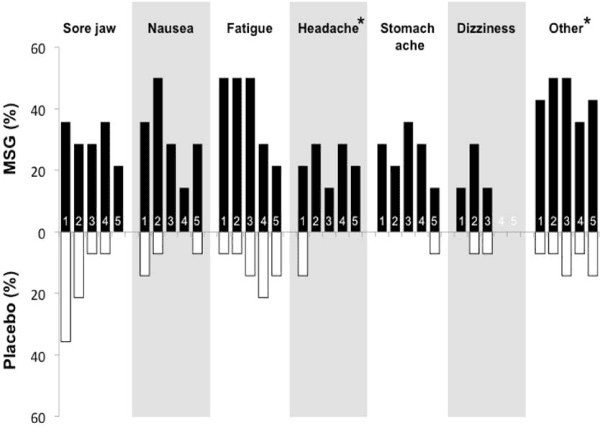
and 5 days of placebo (white) intervention.
Source: Shimada, Akiko & Cairns, Brian & Vad. Headache and mechanical sensitization of human pericranial muscles after repeated intake of monosodium glutamate (MSG). The journal of headache and pain. (2013)
The exact cause of these symptoms is still unknown, but it is suggested that some people may be more sensitive to MSG than others.[2]
Several studies have investigated the link between MSG and adverse reactions. A review published in the Journal of Nutrition found that MSG can trigger headaches in some people, but the mechanism behind this reaction is still not well understood.
Another study published in the Journal of Allergy and Clinical Immunology found that a small subset of individuals may experience short-term reactions to MSG, such as flushing, tightness in the chest, and headaches.[1]
It is important to note that MSG is required to be listed on food labels if it has been added to the product.
The United States Food and Drug Administration (FDA) recognizes MSG as a food ingredient that is generally recognized as safe (GRAS) when consumed in normal amounts, and its use is regulated by the FDA.[2]
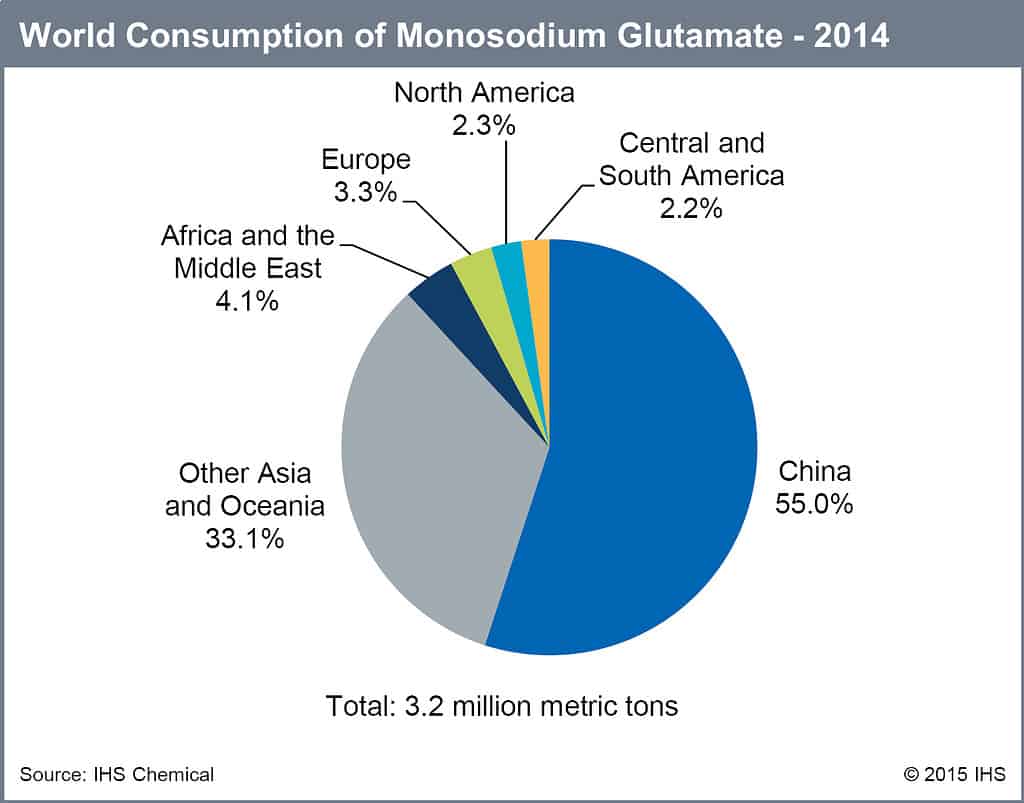
MSG is an approved food additive in Europe, Australia, and New Zealand, with usage limited to the amount necessary to achieve its intended purpose. To ensure consumer safety, FSANZ regulates the permitted amount of MSG in food products.
Dosage and acceptable daily intake of Monosodium Glutamate (MSG)
The Acceptable Daily Intake (ADI) is a metric used to determine the maximum amount of a substance that can be safely consumed every day without causing negative health effects.
The ADI is established by international health organizations and is based on scientific evidence.
The maximum allowed level is set at 1,000 milligrams per kilogram of food.[4]
Foods with the highest concentration of Monosodium Glutamate (MSG)
Many foods contain glutamate, which is the natural form of glutamic acid. However, there is no chemical difference between natural and added glutamate to foods.
| MSG in unprocessed food products | |
| Food name | MSG concentration (mg/100g) |
| Seaweed | 1200 |
| Dried shiitake mushrooms | 1060 |
| Walnuts | 660 |
| Dried tomatoes | 650 |
| Anchovies | 630 |
| MSG in unprocessed food products | |
| Food name | MSG concentration (mg/100g) |
| Marmite | 1960 |
| Parmesan cheese | 1680 |
| Vegemite | 1430 |
| Fish sauce | 1383 |
| Roquefort cheese | 1280 |
Important note — if you are sensitive to MSG, other foods to look out for would be cured meats, different types of sauces and aged cheese.[5]
Sulphites
Sulphites are found in many different foods, both naturally and as added preservatives or flavour enhancers.
When used in the right amounts, sulphites offer several benefits to food products. They are generally used to prevent food spoilage and to preserve colour to manufactured foods.[6]
However, there are also some disadvantages to using sulphites in food products since some people, particularly individuals with asthma or sulfite oxidase deficiency, may experience adverse reactions such as
Dosage and acceptable daily intake of Sulphites
The maximum permitted level of sulphites in food products varies depending on the specific food product and the regulatory agency of the country or region.
In general, the maximum allowed level of sulphites in food products is 300 parts per million (ppm). However, this limit varies by country and food product.
For example, in the European Union, the maximum permitted level of sulphites in food products ranges from 10 to 2,000 ppm, depending on the food product.
Wine can contain up to 200 ppm of sulphites, while dried fruits can contain up to 2,000 ppm.
Excessive consumption of sulphites can be harmful
This is particularly true for individuals who are sensitive to the compound or have a history of adverse reactions.
Therefore, it is recommended to limit the consumption of sulphites in food products and to follow the guidelines and regulations established by the relevant authorities.
Foods with sulphite levels greater than 100 parts per million (ppm) are considered very high in sulphites and levels of more than 10 ppm need to be properly labelled in food products.[9]
Foods with the highest concentration of Sulphites
Major sources of sulphites for children include dried fruit, sausages, drinks, and sometimes hot chips or fries.[10]
| Sulphites in processed food products | |
Food name | Sulphites concentration (ppm or mg/1kg) |
Fully preserved fish (canned products) | 3000 |
French fries | 1900 |
Sauces and toppings | 1000 |
Beverages, non-alcoholic (juices) | 750 |
Alcoholic beverages | 400 |
Other foods that we can mention here are
- Dried Meats (beef jerky): up to 1,500 ppm
- Pickled Foods (pickles, sauerkraut): up to 1,000 ppm
- Shrimp: 20-500 ppm
Sulphites are found in small amounts in unprocessed foods such as black tea, peanuts, broccoli, cabbage, chives, strawberries, plums and blackberries.
Nitrites
Nitrites and nitrates are found in nature and are common in vegetables, fruits and even water. They are also used as food preservatives.
The main difference between nitrites and nitrates is that nitrites are a type of salt that can be used as a food preservative, while nitrates are a naturally occurring compound that can be converted to nitrites in the body.
According to a study published in the Journal of Food Science and Technology, vegetables are the main source of dietary nitrates, accounting for around 80% of total nitrate intake.[11]
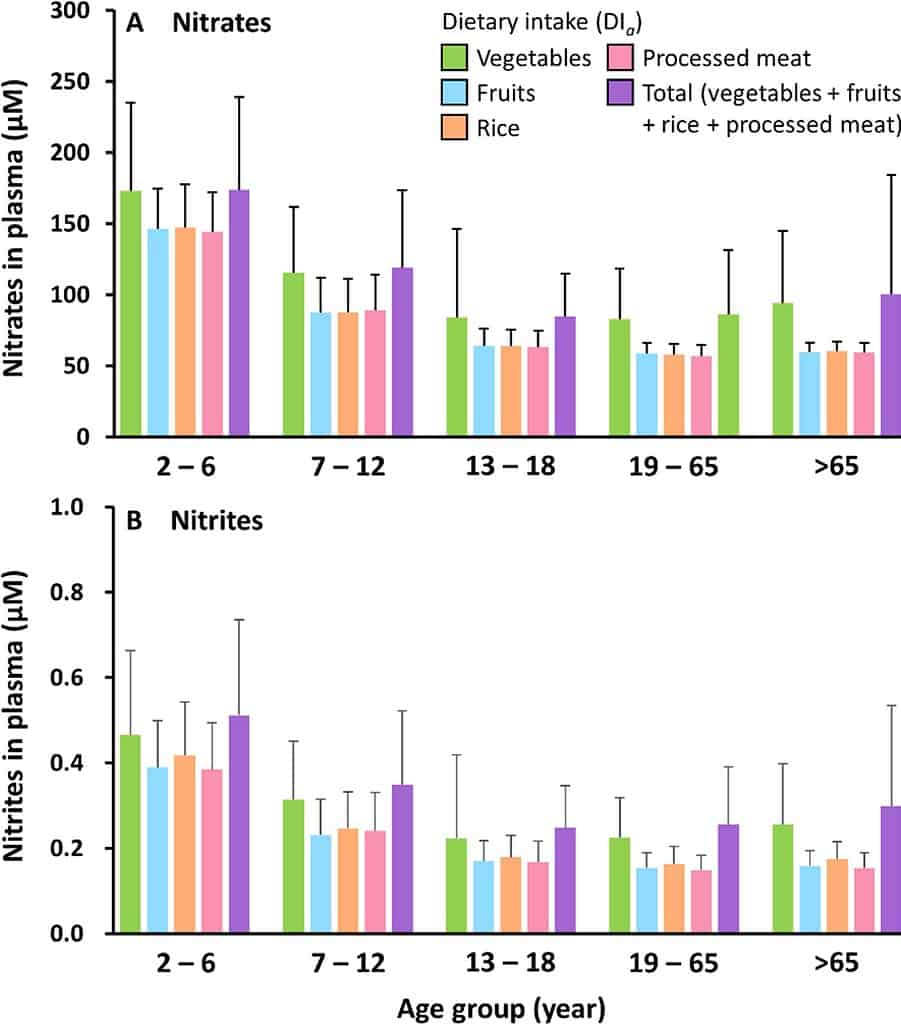
Source: Cheng-Jih Cheng. Probabilistic risk and benefit assessment of nitrates and nitrites by integrating total diet study-based exogenous dietary exposure with endogenous nitrite formation using toxicokinetic modeling. (2021)
Nitrites and nitrates are used in meat products to
- extend shelf life
- improve colour/flavour
- inhibit growth of Clostridium botulinum
Clostridium botulinum causes botulism, a rare but life-threatening condition that causes paralysis.[12]
Studies have found that higher ingestion of water nitrate and higher meat intake can increase the risk of
- colon cancer
- kidney cancer
- stomach cancer
- thyroid cancer[13]
Nitrates in drinking water may cause bowel cancer
Moreover, one study found that cognitive decline was greater in older adults who had higher nitrate intake, though the underlying mechanisms are not fully understood.[14]
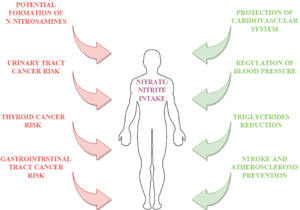
Source: Karwowska M. Nitrates/Nitrites in Food—Risk for Nitrosative Stress and Benefits. Antioxidants. (2020)
That being said, it is important to note that a majority of the nitrates consumed by humans come from fruits and vegetables, which may offer various health benefits such as improving blood pressure, heart function, and exercise performance through the effects of nitric oxide.[15]
Dosage and acceptable daily intake of Nitrates
Acceptable daily intake for nitrates is at 0–0.07 mg/kg body weight per day. This means that a person weighing 70 kg can safely consume up to 4.9 mg of nitrites and nitrates daily.
Presently, the average person in New Zealand consumes approximately 14% of the ADI for nitrites and 18% for nitrates, highlighting the need for caution in dietary consumption of these compounds.[15]
Foods with the highest concentration of Nitrates
Nitrate is a naturally occurring compound found in leafy green vegetables like spinach, beetroot, different root vegetables (carrots and radishes) and fruits like apples and grapes.[16]
| Nitrates in unprocessed food products | |
Food name | Nitrate concentration (mg/kg) |
Arugula Lettuce | 4800 |
Spinach | 2500 |
Beetroot | 2500 |
Celery | 1600 |
Carrots | 1000 |
| Nitrates in processed food products | |
Food name | Nitrate concentration (mg/kg) |
Cured Ham | 900 |
Bacon | 150 |
Corned Beef | 10-100 |
Salami | 10-50 |
Hot Dogs | 10-20 |
Though we can see from the table that processed food products are lower in nitrates, it’s important to keep in mind that they contain other food additives, as well as seed oils and trans and saturated fats.[17]
RELATED — Health Risks: Trans and Saturated Fats
Summary
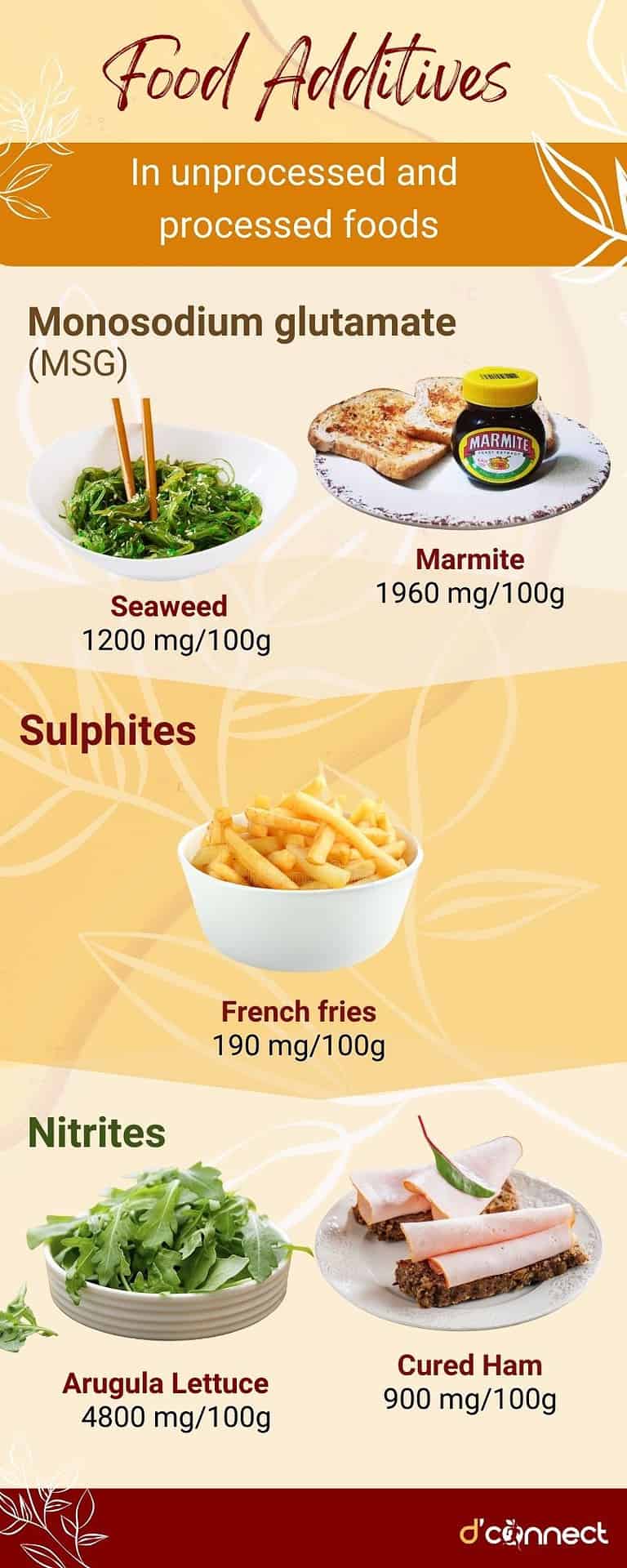
Note — feel free to download and share this illustration.
In Part 2 we will be talking about Intense Sweeteners and Food Colours. In the meantime, you might find the article on artificial sweeteners interesting.
RELATED — Artificial Sweeteners: Are they a Healthy Substitute to Sugar?
Joyce is a dedicated and passionate undergraduate with a keen interest in research and development of novel foods. She is currently completing her studies with a focus on becoming a Bachelor of Food Technology with Honors major in Food Product Technology.
Her personal passion is in finding new technologies and processing methodologies that can improve the existing products in the food market.
References
(1) Questions and Answers on Monosodium glutamate (MSG). FDA. US Food and Drug Administration. Retrieved from https://www.fda.gov/food/food-additives-petitions/questions-and-answers-monosodium-glutamate-msg
(2) Zanfirescu A, Ungurianu A, Tsatsakis AM, Nițulescu GM, Kouretas D, Veskoukis A, Tsoukalas D, Engin AB, Aschner M, Margină D. A review of the alleged health hazards of monosodium glutamate. Compr Rev Food Sci Food Saf. 2019 Jul;18(4):1111-1134. doi: 10.1111/1541-4337.12448. Epub 2019 May 8. Erratum in: Compr Rev Food Sci Food Saf. 2020 Jul;19(4):2330. PMID: 31920467; PMCID: PMC6952072.
(3) Monosodium glutamate or MSG. Ministry for Primary Industries. New Zealand Food Safety. Retrieved from https://www.mpi.govt.nz/food-safety-home/food-additives-preservatives/monosodium-glutamate-or-msg/
(4) MSG in food. Food Standards Australia New Zealand.
(5) High Glutamate Foods. WEBMD. Retrieved from 10 Foods High in Glutamate and Why You Should Avoid Them (webmd.com)
(6) Sulphites. Food Standards Australia New Zealand.
(7) Healthy Food. Ask the experts: Sulphites. Retrieved from https://www.healthyfood.com/ask-the-experts/sulphites/
(8) Sulphites Sensitivity Frequently Asked Questions (FAQ). Australian Society of Clinical Immunology and Allergy. ASCIA. Retrieved from https://www.allergy.org.au/patients/other-allergy/sulfite-sensitivity-faq
(9) Sulfites 101: What are sulfites and are they harmful to my health? Sulfite Free Life. Retrieved from https://sulfitefreelife.com/sulfites/sulfites-101-what-are-sulfites-and-are-they-harmful-to-my-health/
(10) Food intolerance network. Sulphites. Retrieved from https://www.fedup.com.au/factsheets/additive-and-natural-chemical-factsheets/220-228-sulphite-preservatives
(11) Hord, Norman & Tang, Yaoping & Bryan, Nathan. (2009). Food sources of nitrates and nitrites: the physiologic context for potential health benefits1-3. The American journal of clinical nutrition. 90. 1-10. 10.3945/ajcn.2008.27131.
(12) Lee S, Lee H, Kim S, et al. Microbiological safety of processed meat products formulated with low nitrite concentration — A review. Retrieved from https://www.animbiosci.org/journal/view.php?number=23950
(13) Nitrate. National Cancer Institute (NIH). Retrieved from https://progressreport.cancer.gov/prevention/nitrate
(14) Nitrates in drinking-water. Office of the Prime Minister’s Chief Science Advisor. Retrieved from https://www.pmcsa.ac.nz/topics/nitrates/
(15) Preservatives in food: nitrates and nitrites. Ministry for Primary Industries. New Zealand Food Safety. Retrieved from https://www.mpi.govt.nz/food-safety-home/food-additives-preservatives/preservatives-food-nitrates-nitrites/
(16) These 11 Foods High in Nitrates are Rich in Other Nutrients as Well. Opting Health. Retrieved from https://optinghealth.com/foods-high-in-nitrates/
(17) Foods High in Nitrates. WEBMD. Retrieved from https://www.webmd.com/diet/foods-high-in-nitrates






